E-mail: skellabany@hotmail.com
E-mail: emadel_shamy@hotmail.com
Corresponding author. E-mail: eltaibany@hotmail.com
E-mail: nesreenplasma@yahoo.com
Modeling of instability and collision of nonlinear dust-acoustic (NDA) envelope solitons in strongly coupled dusty plasmas (SCDPs) is theoretically investigated. The SCDPs consists of strongly correlated negatively variable-charged dust grains and weakly correlated Boltzmann electrons and ions. Using the derivative expansion perturbation technique, a nonlinear Schrödinger-type (NLST) equation for describing the propagation of NDA envelope solitons is derived. Moreover, the extended Poincaré–Lighthill–Kuo (EPLK) method is employed to deduce the analytical phase shifts and the trajectories after the collision of NDA envelope solitons. In detail, the results show that both modulation instability and phase shift after collision of NDA envelope solitons will modify with the increase in the effects of the viscosity, the relaxation time, and the dust charge fluctuation. Crucially, the modeling of dust-acoustic envelope solitons collision, as reported here, is helpful for understanding the propagation of NDA envelope solitons in strongly coupled dusty plasmas.
At the present time, there is a great deal of interest in perception the physics of dusty plasmas (containing besides electrons and ions also charged microparticles) because of their vital role in understanding the properties of different collective processes in space and laboratory dusty plasmas.[1– 3] It is well known that nonlinear dust-acoustic NDA wave represents one of the important aspects of nonlinear waves in modern dusty plasma researches. Actually, one of the most interesting characteristics of a dusty plasma is the dust charge fluctuation which enters as an extra dynamical variable controlling the dust grain motion.[4] A great number of investigators[5– 7] were studied the modification of the dusty plasma collective properties due to including the dust charge variation. For example, Xie et al.[5] derived dust-acoustic wave with varying dust charge and they showed that only rarefactive solitary waves exist when the Mach number lies within an appropriate regime, depending on the system parameters. On the other side, because of the large charges on the individual dust particles, the dust components in a plasma can be easily in the strongly coupled regime where the electrostatic energy of dust particle interactions greatly exceeds the dust kinetic energy.[8] Theoretically, Ikezi[9] first pointed out that the Coulomb crystallization of charged dust grains interacting via a repulsive Yukawa force in a plasma, when the Coulomb coupling parameter Γ [the ratio between the coulomb interaction energy density and the dust thermal energy Td] exceeds 171. Clearly, large Γ at room temperature is achieved when dust grains acquire tens of thousands electrons on their surface. This theoretical prediction was verified experimentally with the observations of Thomas et al.[10] It is well known that, there are two regimes in the generalized hydrodynamic model: i) the hydrodynamic regime (i.e., ω τ m≪ 1) and ii) kinetic regime (i.e., ω τ m≫ 1), where τ m is the memory (viscoelastic) relaxation time and ω − 1 is the typical time scale of the wave under consideration.[11] On one hand, for the hydrodynamic regime, the viscoelastic relaxation is instantaneous, and one has the usual hydrodynamic equation. In this case dust grains support only the longitudinal dust acoustic wave (LDAW), which suffers only viscous dissipation. On the other hand, for the kinetic regime, the viscoelastic relaxation is not instantaneous, and the dusty plasma supports both LDAW as well as the transverse shear wave.[7, 12]
In last few years, there have been a few theoretical investigations of dust-acoustic wave, double layer, and dust acoustic shock wave in strongly coupled dusty plasmas (SCDPs).[13– 19] For instance, Mamun and Cairns[16] have studied low frequency electrostatic dust modes in SCDPs including dust charge fluctuations. They found that the dust-acoustic wave mode becomes unstable due to the effect of equilibrium dust grain charge inhomogeneity. In addition, they observed that the influence of strong correlations in the dust fluid significantly modify the dispersion properties of the existing dust-acoustic wave mode. Recently, Rahman and Mamun[18] have investigated a SCDP containing strongly correlated negatively charged dust grains and weakly correlated adiabatic effects. They demonstrated that both the dust-acoustic wave and the dust acoustic shock wave are found to exist with negative potential only[18] Furthermore, the effects of a modulational instability (MI) of nonlinear wave in SCDPs have not investigated enough.[20] Moreover, Veeresha et al.[8] reported that the dust-acoustic wave can suffer a MI at short wavelengths such that a slow parallel modulation of a finite amplitude monochromatic plane wave and in some limits lead to the formation of an envelope soliton pulse. Additionally, they[8] have demonstrated that the effective dust temperature and the effects of polarization force, respectively, are very important to illustrate various characteristics of the dust-acoustic wave propagation in many space and laboratory dusty plasma situations. Very recently, El-Labany et al.[21] examined the MI of the modulated dust acoustic envelope solitons in SCDPs including the polarization force effect only. They demonstrated that as the effect of polarization force increases, both the angular frequency and the group velocity of the dust acoustic envelope solitons decrease.
Presently, in the process of soliton propagation in SCDPs, wave– wave collision has attracted more and more attention in modern plasma researches. Actually, one of the striking properties of solitons is their asymptotic preservation of form when they undergo a collision.[22] The unique effects due to the collision are their phase shifts and trajectories. Many authors have investigated the collision of two solitary waves in various plasma models using the extended Poincare– Lighthill– Kuo (EPLK) method.[23– 27] The EPLK method has been employed to study wave– wave collision in dusty plasmas.[28, 31] For example, Xue[28, 29] demonstrated that the dust charge fluctuation and the magnitude of the magnetic field have strong effects on the phase shifts. Later, Li et al.[30] illuminated that the value of phase shift increases as the angle between the propagation directions of the two dust acoustic solitary waves increases. Recently, El-Labany et al.[31] stated that the oblique collision strongly affects the trajectories of dust acoustic solitary waves after collision. In addition, very recently, El-Labany et al.[21] have firstly addressed the head on collision of two modulated dust acoustic envelope dark solitons in the hydrodynamic regime in SCDPs through the nonlinear Schrö dinger equation framework. They[21] showed that the phase shifts for the dark solitons increase as the effect of polarization force decreases. Up to now, the collision of two NDA envelope solitons in the kinetic regime of SCDPs has not been performed. Furthermore, particular questions to be answered are: how do MI, angular frequency, group velocity, and the collision of the NDA envelope solitons are influenced by the incorporated new effects; the viscosity, the relaxation time and the dust charge fluctuation. Therefore, it is expected that the answers of these questions will lead to a significant improvement for understanding nonlinear wave collision observed in SCDPs experiments.
This paper is organized in the follows: In Section 2, the basic equations for describing NDA envelope solitons in SCDPs within the kinetic regime are introduced. In Section 3, the derivative expansion technique is used to derive a nonlinear Schrö dinger-type (NLST) equation, then studying MI of NDA envelope solitons in various regions of the physical parameters involved. In Section 4 using the EPLK method, the analytical phase shifts and the trajectories after the collision are deduced, and the collision between two NDA envelope dark solitons is discussed. Based on physical parameters, Section 5 is devoted to show numerical illustrations and the discussion of the present findings. Section 6 is devoted to concluding remarks.
Let us consider SCDPs consisting of negatively variable-charged dust grains, electrons, and ions. The electrons and the ions are considered weakly coupled due to their higher temperatures and smaller electric charges, while the dust grains are assumed to be strongly coupled because of their low temperature and large electric charges. The charge neutrality condition reads Zd0nd0+ ne0 = ni0, where ne0, ni0, and nd0 are the unperturbed number densities of electrons, ions, and dust grains, respectively, and Zd0 is the unperturbed number of electrons residing on the dust grain surface. Owing to the low phase velocity of dust acoustic waves (in comparison with electron and ion thermal velocities), the electrons and the ions are assumed to behave as light fluids compared to the dust fluid and model them by Boltzmann distribution


The set of equations describing the proposed SCDPs fluid in kinetic regime is governed by[17, 19]



where nd is the dust number density, ud is the dust fluid speed, φ is the electric potential. t and x are the time and the space variables, respectively. The third term on the left-hand side of Eq. (4) is due to the polarization force, which arises due to the interaction between thermal ions and highly negatively charged dust grains, one can defined the polarization force as Fp = − eZdR(ni/ni0)1/2∇ φ , where R(= Zde2/4λ Di0Ti) is a parameter determining the effect of polarization force, and λ Di0 = (Ti/4π ni0e2)1/2. Ti(e) is the ion (electron) temperature in energy unit, ni(e) is the ion (electron) number density, Zd is the number of electrons residing on the dust grain surface, and e is the magnitude of the electron charge. The fourth term represents the pressure force, and the fifth term is the viscosity force, which is introduced by taking the kinematic viscosity among the plasma constituents into account. md is the dust grain mass, Tef= (Tdμ d+ T* is the effective dust temperature consisting of two parts: T* arising from the electrostatic interactions among highly negatively variable-charged dust grains and Tdμ d arising from thermal pressure and

where τ m is the viscoelastic relaxation time, μ d is the compressibility, and η l is the longitudinal viscosity coefficient. The parameters T* , τ m, and μ d are given by[32]

where Nnn is determined by the dust structure and corresponds to the number of the nearest neighbors, 

It is well known that the dust grains are negatively charged due to plasma electron current

and ion current

and the charges on the dust grains varies continuously with time. The varying dust charge qd is governed by the current balance equation[33]

Now, let us write the normalized set of equations for SCDPs fluid as follows:




where the normalized electron current and normalized ion current are given by

Here, the variables ne, ni, and nd are normalized by Zd0nd0, Zd0nd0, and nd0, respectively, ud by λ Dω pd, φ by Ti/e, t by 




The dust charge is defined by qd = − eZd = rdφ = rdTiψ /e; accordingly the normalized dust charges Zd = ψ /ψ 0 where ψ 0 = ψ at φ ; = 0) is the surface floating potential with respect to the unperturbed plasma potential at an infinite place, which can be calculated from α 1δ (1− ψ 0) − exp (σ ψ 0) = 0. Let us introduce the following notations: The dust plasma frequency 



To examine the propagation of NDA envelope solitons in the proposed SCDPs, we analyze the outgoing solutions of Eqs. (7)– (12) by introducing the stretched coordinates[34]

where ϵ is a small (real) parameter and λ is the envelop group velocity to be determined later. The dependent variables are expanded as

where 







The L = 1 (first harmonic) components lead to

where

with the neutrality condition μ i = 1+ μ e. Moreover, in this order, we can derive the linear dispersion relation as

This dispersion relation coincides exactly with that derived by El-Taibany and Kourakis, [6] upon omitting the nonthermality a = 0 (a is the nonthermal parameter introduced in their work)[6] and neglecting the viscosity η l and the polarization effect. In addition, it agrees with the expression derived by Veeresha et al.[8] for the dust acoustic mode in SCDPs in short wavelength regime with R and η l equal zero. On the other side, if we return back to the hydrodynamic regime (ignoring dust charge variation) ω τ m≪ 1, equation (20) agrees exactly with the form of Amin et al.[35] by setting (R = γ * = η l= θ = 0); (θ is introduced in the work of Amin et al.[35]). Ignoring the dust charging fluctuation, by setting g1 = 0, and with η l = 0, this dispersion relation coincide with that derived in El-Labany et al.[21] Moreover, the group velocity λ is given by

Furthermore, from the (L = 1) component of the third-order equations (n = 3), and after some algebraic manipulation, we obtain the following nonlinear Schrö dinger-type (NLST) equation for the NDA envelope solitons as[36]

In Appendix A, we derive Eq. (22). For simplicity, we have denoted 
It is noticed here, as well-known, if PQ > 0, the modulated envelop is “ unstable” for 
It is well known that the most interesting feature of dark solitions is their threshold generations. Therefore, dark solitons can be created by an arbitrary small dip on a continuous wave background. In this section, we try to describe the interaction of two NDA envelope dark solitons in the kinetic regime of SCDPs using the EPLK perturbation method.[24– 27] Firstly, we assume two NDA envelope dark solitons, one of which is traveling to the right, and the other one is going to the left. After some time they interact, collide, and then depart. Secondly, the analytical solution of the NLST Eq. (22) of equal small amplitudes can be written as[37, 38]

where φ 0 an arbitrary constant represents the amplitude of the background far from the dark soliton of amplitude a(τ , ξ ) ≪ φ 0, [39] and ϕ (τ , ξ ) is the phase function contributed from the excitation which is assumed to be a function of τ and ξ . Substituting Eq. (23) into Eq. (22), we obtain the following two equations:


The following asymptotic expansions are used to obtain the NDA envelope dark solitons solutions of Eqs. (24) and (25)


where ε is a small parameter characterizing the strength of nonlinearity. We assume that a(j) and ϕ (j) (j = 1, 2, … ) are functions of the multiple-scale variables, which are given by[38]


referring in ζ and η to a right- and to a left-propagating dark soliton, SR and SL, respectively. The wave speed cR and cL are to be related to the amplitudes of the waves. The functions P(j) and Q(j) (j = 0, 1, 2, … ) are to be determined in the process of our solution of Eqs. (24) and (25). The aim of introducing these functions is to make a uniformly valid asymptotic expansion (i.e., to eliminate secular terms) and at the same time obtain the change of the trajectories (i.e., phase shifts) of the NDA envelope dark solitons after collision. Now, let us introduce the asymptotic expansion


Putting Eqs. (26)– (29) into Eqs. (24) and (25), we obtain


We can calculate the local wave speed as 
To the next higher-order, the solvability conditions for a(1) and φ (1) give




where
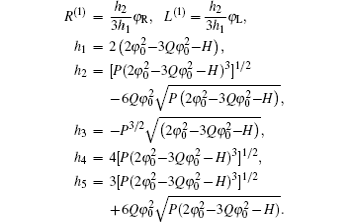
Equations (34) and (35) are the two-side traveling wave Korteweg– de Vries (KdV) equations in the reference frames of ξ and η , the one-soliton solutions of Eqs. (34) and (35), are given by[40]


where φ R and φ L are the initial amplitudes of the two NDA envelope dark solitons SR and SL in their initial positions. Moreover, after some algebraic steps, one can obtain the corresponding phase shifts.[40, 41] Details are given in Appendix B, that is


Before going to the discussion, it should be mentioned here that, the numerical values of the physical parameters are selected based on actual experimental data as follows:[17, 42]

Furthermore, under the condition ω τ m ≫ 1 (i.e., the kinetic regime), η l is a finite quantity, which makes the transition from the fluid to the solid state. This means, physically, that correlation energies of dust particles change due to a change in the order of the arrangement of the dust particles with increased correlation effect. Accordingly, the viscosity force represented by η l(∂ 2ud/∂ x2) plays in this case the role of a restoring force rather than a dissipative one.[21]We can summarize the effects of these new physical parameters on the MI and collision of NDA envelope solitons as follows. Figure 1 shows that ω increases as η l or k increases though it decreases as τ m increases. On the contrary, we have found that λ (decreases) increases as (either k or τ m) η l increases, (cf., Fig. 2). Figure 3 demonstrates the contour plot of the product PQ in the k– R domain. It illustrates two specific stable regimes for the NDA envelope solitons; in between an unstable regime is created. The middle (unstable regime is located insides the two contours denoted by “ 0” . Figures 4– 6 illustrate the contour plots of the product PQ against including dust charge variation, η l, and τ m, respectively. These illustrations reveal that including the dust charging fluctuations leads to an expansion of the stable regime of the NDA envelope solitons by shifting the critical wavenumber boundary to a higher value. However, increasing the longitudinal viscosity (relaxation time), η l (τ m) leads to a reduction (an expansion) of the stable domain for NDA envelope dark solitons, respectively. In all cases, for large wavelength limit seems to predict stability, as physically expected. Let us now interpret the dependence of the NDA envelope dark solitons phase shifts and trajectories, released after collision occurred, on the system physical parameter variations. Cleary, the magnitude of the phase shift depends on the initial amplitudes of NDA envelope dark solitons with large amplitudes causing large phase shifts (see. Eqs. (40) and (41)). Furthermore, dark soliton SR is traveling to the right and dark soliton SL is going to the left, we see from Eqs. (40) and (41) that due to collision, each dark soliton has a negative phase shift in its traveling direction. Physical interpretation for a negative phase shift phenomenon is that during the colliding process, two NDA envelope dark solitons decrease their velocities, which lead to change in their trajectories after collision stage.
 | Fig. 1. Variation of ω against the wave number k for different values of viscosity coefficient η l with R = 0.2 (a) and the relaxation time τ m with R = 0.4 (b). |
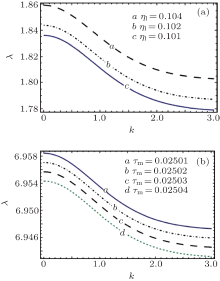 | Fig. 2. Variation of the group velocity λ against the wave number k for different values of η l with R = 0.2 (a) and τ m with R = 0.4 (b). |
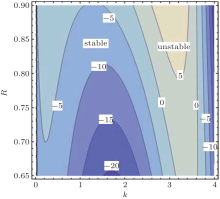 | Fig. 3. The contour plot of the product PQ defining stable/unstable regime with τ m = 0.025. The contours with the value “ 0” are separators between stable and unstable regimes. |
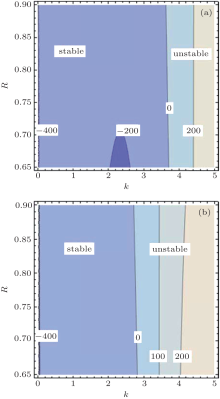 | Fig. 4. The contour plot of the product PQ with η l = 0 by including dust charge variation effect (a) and with constant dust charge (b). |
Figure 7 demonstrates the numerical simulation result of the amplitude a(τ , ξ ) of the two NDA envelope dark solitons against the space coordinate ξ and the time variable τ is represented in. It shows that after the collision, the two NDA envelope dark solitons propagate along the trajectories deviated from the initial trajectories, which is the phase shift. Figures 8 and 9, respectively, show how η l and τ m affect the profile of the two NDA envelope dark solitons against the space coordinate ξ and the time variable τ . It is obvious that the phase shift increases with increasing either η l or τ m. Therefore, the phase shifts for NDA envelope dark solitons depend directly on η l and τ m. Figure 10 represents the variation of the phase shift Δ Q0 with k for various values of R in two cases: with and without dust charge fluctuation. The figure points out that the phase shift Δ Q0 increases as R decreases. Owing to the inclusion of the charge fluctuation in our model, the magnitude of phases shift Δ Q0 increases. The point to be stressed here is that, the dust charge fluctuation has a strong effect on the phase shift.
 | Fig. 7. The colliding process of two DA waves. The amplitude, a(τ , ξ ), of two dark solitons is illustrated. |
 | Fig. 8. Space-time plot is presented for different values of η l with k = 0.3, ε = 0.01, R = 0.2, and φ a = φ b = 0.2. |
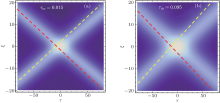 | Fig. 9. Space-time plot is presented for different values of τ m with k = 0.3, ε = 0.01, R = 0.2, η l = 0.02, and φ a = φ b = 0.2. |
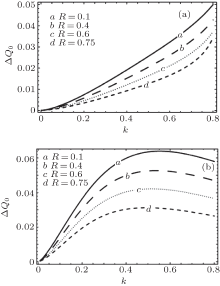 | Fig. 10. The variation of the phase shift Δ Q0 against k for different values of R without dust charge variation and viscosity effect η l (a) and including dust charge variation while the viscosity effect is omitted (b). |
In summary, the MI and the collision of two NDA envelope solitons in a SCDP system in the kinetic regime have been investigated. Using the derivative expansion perturbation technique, the NLST equation is derived. The instability domain for the NDA wave is estimated. The EPLK method has been employed to obtain the analytical phase shifts after the collision of NDA envelope dark solitons. It is clear that the wave form of the colliding NDA envelope dark solitons remain unchanged. Analytically and numerically, the effects of the viscosity η l the relaxation time τ m, and the dust charge fluctuation are investigated. It is found that the phase shift and the stable domain increase with increasing the longitudinal viscosity. Moreover, increasing the relaxation time leads to an increase of the phase shift and the stable domain. This means, physically, that the increase of η l (τ m) leads to an increase (a decrease) of the group velocity λ , which in turn leads to an increase (a decrease) in the restoring force, which makes the NDA envelope dark soliton taller (shorter). Accordingly, the obtained result indicates that the stable domain and the phase shift for NDA envelope dark solitons decrease (increase) with the increase of η l (τ m). Finally, the dust charge fluctuation affects strongly on the nature, the stability domain and the phase shift of NDA envelope solitons. Evidently, including the dust charge fluctuation extends the stable domain and decreases the magnitude of phase shift. Furthermore at τ m = 0 (i.e., relations time is instantaneous), it is worth noticing that the usual hydrodynamic equation is considered. However, in our investigation we have considered the dust charge fluctuation in the kinetic regime, where the relaxation time τ m is much larger than the dust fluid dynamic time (NDA envelope solitons), which gives rise to different physical behavior as interpreted. In addition, it is useful to compare our results with the results of El-Labany et al.[21] Properly, this work agrees with the results of El-Labany et al.[21] by neglecting the viscosity, the relaxation time, and the dust charge fluctuation. Hence our model, in the kinetic regime, is more general and can describe the propagation and the collision of two NDA envelope dark solitons by the derivative expansion perturbation technique and the EPLK method, respectively.
| 1 |
|
| 2 |
|
| 3 |
|
| 4 |
|
| 5 |
|
| 6 |
|
| 7 |
|
| 8 |
|
| 9 |
|
| 10 |
|
| 11 |
|
| 12 |
|
| 13 |
|
| 14 |
|
| 15 |
|
| 16 |
|
| 17 |
|
| 18 |
|
| 19 |
|
| 20 |
|
| 21 |
|
| 22 |
|
| 23 |
|
| 24 |
|
| 25 |
|
| 26 |
|
| 27 |
|
| 28 |
|
| 29 |
|
| 30 |
|
| 31 |
|
| 32 |
|
| 33 |
|
| 34 |
|
| 35 |
|
| 36 |
|
| 37 |
|
| 38 |
|
| 39 |
|
| 40 |
|
| 41 |
|
| 42 |
|




